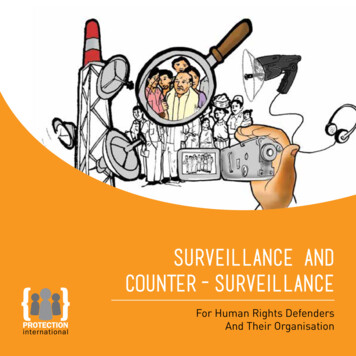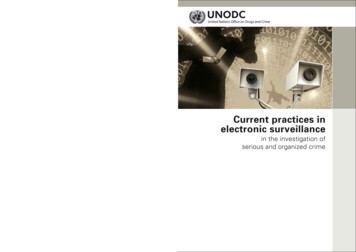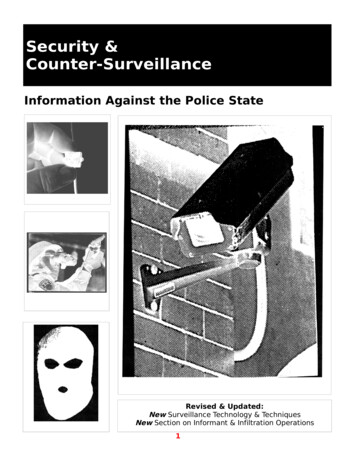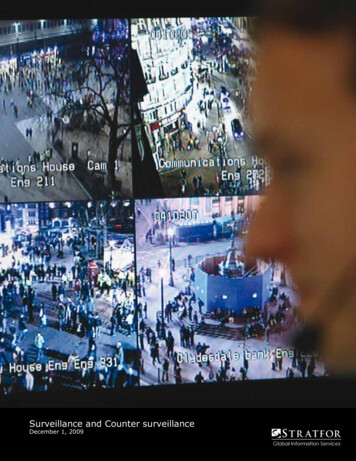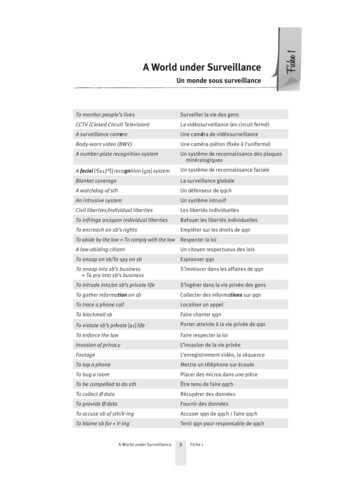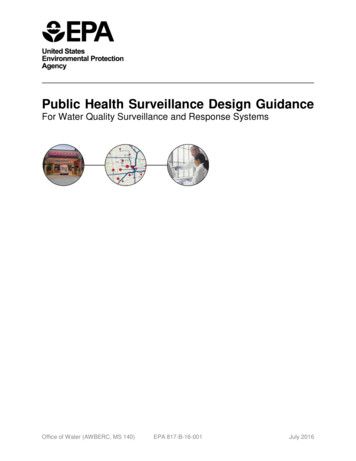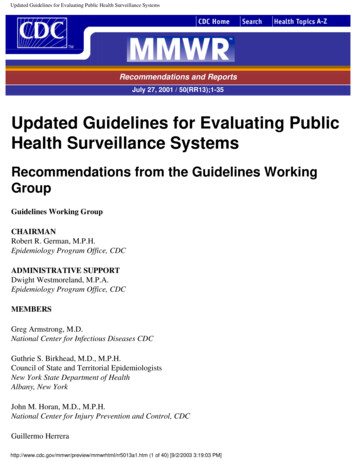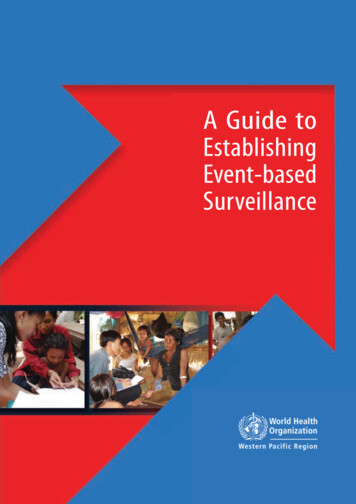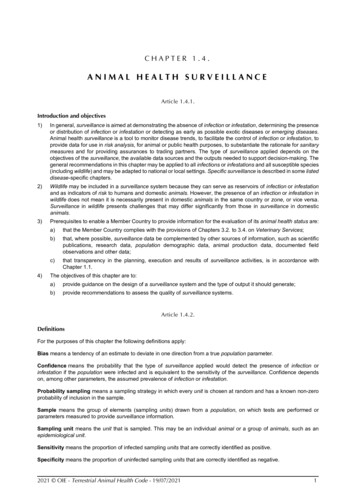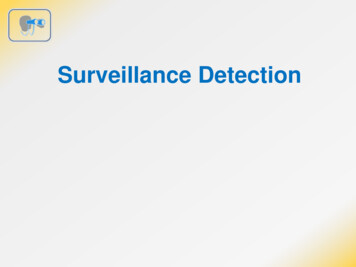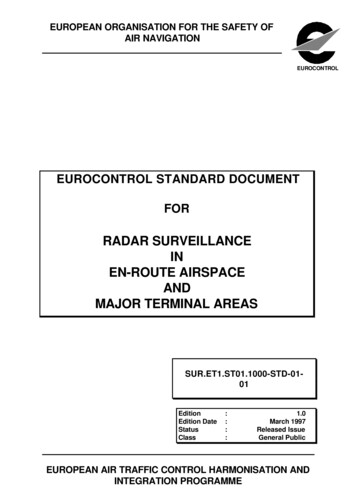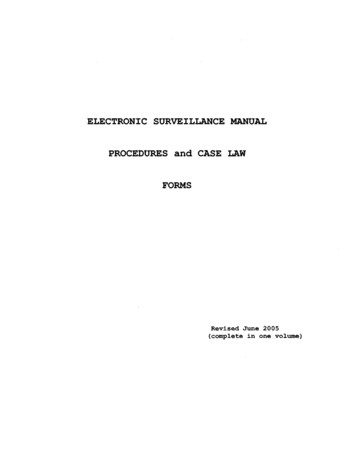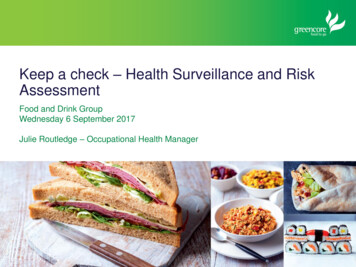
Transcription
Keep a check – Health Surveillance and RiskAssessmentFood and Drink GroupWednesday 6 September 2017Julie Routledge – Occupational Health Manager
Bit about me . Worked in Occupational Health for 24 yearsPG Diploma and Specialist Practitioner in Occupational Health obtainedfrom University of SurreyMostly manufacturing – Weetabix, Mars Petcare, Perkins Diesel Enginesand currently GreencoreSet up 2 OH services Health Surveillance and Fit for Purpose medicals from beginning
What is Health Surveillance Health surveillance allows forearly identification of ill health andhelps identify any corrective actionneeded.Health surveillance may berequired by law if your employeesare exposed to noise or vibration,solvents, fumes, dusts, biologicalagents and other substanceshazardous to health, or work incompressed air.Source: HSE accessed index.htm
So what do we need to considerLegislation for statutory requirements Noise at work Control of Substances Hazardous to Health Manual Handling Lead Mercury Asbestos Vibration Compressed Air Radiation
Fit for purpose screeningWhat else/Fit for Purpose?Not a legal requirement but considered best practice New starter Screening - baselineWorking Time Directives – NightworkerFood HandlersDrivers – Vocational and FLT etcWorking in Hot/Cold environments
Health Risk Assessment 5 steps to risk assessment Identify the health hazardWho is at risk from the health hazardWhat are the current control methods – are they suitable to control the risk?What more should be done – action plan, health checks etcMonitor and review
Occupational Health AssessmentTypes of medicals Statutory––––––––COSHH (EH40) – Questionnaire, lung function, skin checkNoise – Questionnaire, audiometryLead – Biological Monitoring - blood testsMercury – Biological monitoring - blood/urine testsAsbestos – X-ray,Compressed Air – Questionnaire, lung functionRadiation – Questionnaire, lung, skinHand Arm Vibration – Questionnaire (Tier 1)Fit for purpose––––––Drivers – Questionnaire Eye Test,Food Handlers – skin check, symptoms, underlying conditionExtremes of Temperature - QuestionnaireSkin – Questionnaire, visual checkNightworker - Questionnaire,Musculoskeletal – Questionnaire, monitoring
Where do we start
Where do you start Know the siteWalk the areaHealth and Safety – Review risk assessmentsCarry out Health Hazard MatrixHealth Hazard Audits
Where to startAct: Decide who isgoing to carry out thehealth checksPlan: Review riskassessmentsDo we have a health risk?Do: Carry out aworkplace auditHealth Risk MatrixHealth Hazard AuditDetermine whorequires the HealthCheckComplete screeningand keep all recordsMonitor results andact if requiredRecall - frequencyCheck: Currentcontrols are theysuitable and sufficient?Do I need to carry outhealth checks?
Role/TaskPRODUCTION OPERATIVEXXXXXAREASUB AREAAssessed ByDateFood HandlingVulnerable PersonRadiationBiological HazardsThermal - Working in Hot/ColdLone WorkingWorking at HeightExposure to Lead, asbestos,mercuryWhole body VibrationPsychological RiskNight ShiftUltra VioletLight/Electromagnetic fieldDisplay Screen EquipmentMusculoskeletal Risk -WRULDVibrating ToolsDriving – Fork Lift, HGV, LGV,Pallet Truck etcConfined SpaceWeldingSubstance Hazardous to HealthHealth Hazard RiskAssessment MatrixNoiseHealth Hazard MatrixX
Health Hazard AuditSection A: Area Assessment SummaryFactoryassessed:Assessed by:Factory 1Julie RoutledgeAreaassessed:Shift times:High Care LineSub areaOps7 day a week manufacturing – 2200 to 16.30Health hazard identified1. Exposure to NoiseControl measuresNoise survey, Hearing protection zones, noise actiongroup looking to reduce noise levels at source2, Work related upper limb Suitable rest and recovery, rest breaks, manualdisordershandling training, Risk assessment, rotation of tasksWorking in a cold environment Wearing of layers of clothing, gloves provided, restperiods, Occupational Health Assessment3, Shift WorkRedeployment opportunities to move to days ifrequested4. Demand of Role – keeping Management supervision, suitable rest and recoveryup with line speed/productionrun5. Exposure to food contact – Assess to Occupational Health, gloves are provided,risk of allergy, hand washing – soaps and detergents suitable for food manufacturing,risk of dermatitismoisturiser providedMedical Screening InterventionAudiometry as a baseline on joining Greencoreand then every 2 years thereafterMusculoskeletal Assessment6. Quality Monitors – Taste Occupational Health AssessmentPanel – risk of food allergyFood Handlers medical every 2 yearsGeneral Health QuestionnaireNight worker Assessment every 2 yearsNone requiredsurveillancemonitorduringmedicalFood Handlers medical every 2 years – skincheckAre there any considerations to this area for vulnerable employees – including but not exclusive to pregnancy/young persons – Pregnancyrisk assessment required to consider static standing, shift work and Only for Quality Monitors – Taste panelComments:Rotation of tasks is key in reducing the impact of work related upper limb disordersOverall Health Risk RatingDate 23 May 2017Low Risk as long as control measures are observedReview DateMay 2020
Health Hazard AuditSection B: Health Hazard breakdownOccupational HealthDo any of the following occupational health hazards exist?1.Physical hazardsIs there a risk of/fromYes/No Comments/current controlsWorking at heightVehicular/FLTConfined spaceMachinery/mechanicalVibration – use of power tools, wholebody vibrationLone workingNoiseRadiationMusculoskeletal Injury – WRULDBack InjuryErgonomics – is the areaergonomically designed?Thermal hazards such as:heat (direct/radiated)humidityCold/chill storeAny other physical hazards?2. Chemical hazardsDo any of the following hazardsexist in this quidsCleaning agentsYes/NoComments/current controls –Health Hazard Assessment
Health Hazard Audit3. Biological hazardsRoutine exposure to biohazards. Ifyes, listYes/NoComments/current controls4. Manual Handling/ErgonomichazardsIs there a risk from ManualHandling or Ergonomics?Comments/current controlsIs the risk: LOWMEDIUMHIGHIf the risk is med-high has a manualhandling risk assessment beencarried out?If Yes is it suitable and sufficient tocontrol the risk?Comments:5. Psychological hazardsDo any psychological hazardsexist? If yes listShift WorkLean crewing, future changesAre there any concerns for WRS?Additional comments:SignatureComments/current controlsDate
Health Hazard AuditsOverall Risk Assessment RatingSEVERITY OF HEALTH EFFECTTaking into account what isknown so far, how severe ahealth effect could working inthis area have on personnel?Severity – 2 x Likelihood 1 2 Low riskNot severeSevere (off work for 3 days ormore)Score 1Score 2Score 3LIKELIHOOD OF OCCURANCEUnlikelyLikelyHaving considered the controlmeasures, what is thelikelihood of personneldeveloping a health risk?Score 1RISK RATING SEVERITY x LIKELIHOODAction:Very severe (long term illness)Score 2Highly likelyScore 3ENTER RISK RATING HERE: 2 A risk rating of 1 or 2 indicates that existing management arrangements are adequate andthe risk is LOW A risk rating of 3 or 4 indicates that a review of current arrangements should take place andthe risk is MEDIUM and changes made within 4 weeks A risk rating of 6 or 9 indicates that the current arrangements for health protection areinadequate and that urgent action should be taken to remedy the situation and the risk isHIGH
Health Task sheet and surveillance programmeHealth RiskRiskWho may require thisPaperworkRequiredGeneral HealthQuestionnaireFood HandlerQuestionnaireMedical RequiredCriteria/StandardFrequencyNew StarterLOWAll employeesBaseline audio, spirometry,skin assessment, IshiharaPlatesRefer to OHA if any underlying healthcondition that may cause an impacton their ability to carry out their roleWithin 12 weeks of commencingemployment. 4 weeks for all foodhandlersExposure toNoiseHIGHEngineers, Ultra Sonic Cutters,Machine Minders, tray wash, porters,dispatch or any employee wherenoise levels are above 85 dB (A)AudiometryQuestionnaireAudiometryRefer to GP/OHA if CAT 3At baseline then every 2 years.More frequent if results showvulnerability (CAT 2, CAT 3)Annual for EngineersAny CAT 2 - Warning advise to wearhearing protectionExposure toSubstancesHazardous tohealthHIGHHygiene, Engineers, Welders, Yard,Diesel Tank, Dries RoomRespiratory andSkinQuestionnaireSpirometry and skinassessmentRefer to OHA if Spirometry showingrestriction or obstruction or anysymptoms of rhinitis (exc. hayfever)Welders and Dries/Spices - Oncommencing employment, at 12weeks, 24 weeks at 1 year thenannually thereafter.All others on commencingemployment and annuallythereafterFood HandlerLOWAll employees who come into contactwith unsealed/open food within lowor high careFood HandlerQuestionnaireSkin examination, nail check,dental check.Check for respiratory or boweldisordersRefer to OHA if any underlying healthcondition that may cause an impacton their ability to carry out their role,or a danger to the productEvery 2 yearsYard Workers, Dispatch, Goods In,Engineers, Unit E, HygieneVocational DriverQuestionnaireBlood pressure, vision test,musculoskeletal assessmentof back and neck, whisper testor audiometryRefer to OHA if vision acuity is 6/7.5or monocular visionHypertensive – Diastolic 95Uncontrolled DiabetesMedical history of cardiac, epilepsy,blackouts, faints or anything ofconcern.Prior to becoming a driver andevery 3 years thereafter.Reach TrucksLOWinc. FLT,Counterbalance,Cherry Pickersetc.Assessment after travel or illnesson return to workAnnual after 60 years of ageFull assessment after any illnessthat may affect driving
Area Register Select the people that matches the planSURNAME ygiene67890 OpHygiene35679 supervisorHygiene12345 OpHygiene10484 OpHygiene10489 OpHygiene10484 OpHygiene10442 OpHygiene10480 OpFoodHandler SkinDate ofMSK Noise Nights COSHH MedicalxxxxxxxxxxxxxxxxxxxxxxxxxxDate ofnextmedicalOutcomex01/01/2017 01/01/2018 Fitx05/01/2017 05/01/2018 Fitx02/05/2017 02/05/2018 baseline medical completed - fitx01/01/2017 01/01/2018 Fitx01/01/2017 01/01/2018 Fitx01/01/2017 01/01/2018 Fitx01/01/2017 01/01/2018 Fitx10/07/2017 10/07/2018 Fit
Prioritising Safety criticalSensitising AgentsArea of concernIndividual concern – e.g. poor hearing – carry out more frequent
Trends & Data What is the surveillance programme saying?
Don’t forget Adding New StartersRemoving LeaversFit slipChange of positionNew chemicals on site – is OH part of the COSHH assessment?
Thanks for listeningAny Questions ?
handling training, Risk assessment, rotation of tasks Musculoskeletal Assessment Working in a cold environment Wearing of layers of clothing, gloves provided, rest periods, Occupational Health Assessment General Health Questionnaire 3, Shift Work Redeployment opportunities to move to days if requested Night worker Assessment every 2 years 4.
